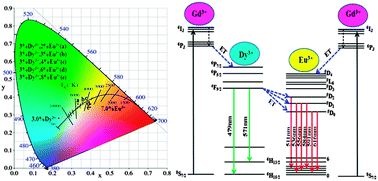Tunable luminescence and energy transfer properties of NaGdF4:Dy3+, Eu3+ nanophosphors
Abstract
A series of tunable luminescence NaGdF4:Dy3+, Eu3+ nanophosphors have been synthesized for the first time by a one-step hydrothermal method. X-ray diffraction (XRD), field emission-scanning electron microscope (FE-SEM), X-ray energy dispersive spectrometer (EDS) and photoluminescence (PL) spectroscopy were employed to characterize the samples. Under the excitation of UV light, NaGdF4:Dy3+ and NaGdF4:Eu3+ exhibit the characteristic emissions of Dy3+ (4F9/2 → 6H15/2, blue and 4F9/2 → 6H13/2, yellow) and Eu3+ (5D0 → 7F2, red), respectively. It is found that in a Dy3+, Eu3+-codoped NaGdF4 system, the energy is transferred from Dy3+ to Eu3+ by the photoluminescence spectra and faster decay times of the blue emissions from energy donors (Dy3+). Moreover, the energy transfer is efficient and certified to be a resonant type via a quadrupole–quadrupole interaction by comparing the experimental data and theoretical calculation. The corresponding luminescence and energy transfer mechanisms have been proposed in detail. Most interestingly, the white light with varied hues has been obtained in Dy3+ and Eu3+ co-activated NaGdF4 phosphors by utilizing the principle of energy transfer and properly designed activator contents. The results show that the obtained nanophosphors have a promising application in display and lighting fields.


 Please wait while we load your content...
Please wait while we load your content...